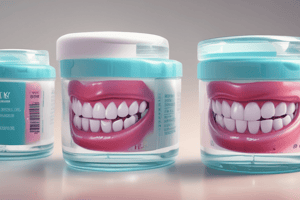Podcast
Questions and Answers
What is the purpose of the residual titration method in this experiment?
What is the purpose of the residual titration method in this experiment?
The purpose is to determine the amount of zinc oxide in a pharmaceutical preparation.
What are the products formed in the reaction of zinc oxide with sulfuric acid?
What are the products formed in the reaction of zinc oxide with sulfuric acid?
The products formed are zinc sulfate (ZnSO4) and water (H2O).
Explain the role of methyl orange in the titration procedure.
Explain the role of methyl orange in the titration procedure.
Methyl orange acts as an indicator to show the endpoint of the titration.
How is the excess sulfuric acid determined after the reaction with zinc oxide?
How is the excess sulfuric acid determined after the reaction with zinc oxide?
What is the significance of heating the mixture until a clear solution is obtained?
What is the significance of heating the mixture until a clear solution is obtained?
Calculate the number of milliequivalents of ZnO if 50 ml of 1N H2SO4 is used and 2.5 g of NH4Cl and 1N NaOH are involved in its reaction.
Calculate the number of milliequivalents of ZnO if 50 ml of 1N H2SO4 is used and 2.5 g of NH4Cl and 1N NaOH are involved in its reaction.
Why is zinc oxide categorized as hazardous in case of inhalation?
Why is zinc oxide categorized as hazardous in case of inhalation?
What is the significance of the theoretical weight of 0.5 g ZnO in the context of calculating weight percentage?
What is the significance of the theoretical weight of 0.5 g ZnO in the context of calculating weight percentage?
Describe the role of excess H2SO4 in the reaction involving ZnO and NaOH.
Describe the role of excess H2SO4 in the reaction involving ZnO and NaOH.
What are the potential chemical dangers associated with ammonium chloride when heated?
What are the potential chemical dangers associated with ammonium chloride when heated?
Flashcards are hidden until you start studying
Study Notes
Residual Titration Method
- Definition: A technique where excess standard solution reacting with an analyte is determined by titration with a second standard solution.
Assay of Zinc Oxide
- Aim: To determine the amount of zinc oxide within a pharmaceutical preparation.
Introduction
- Zinc Oxide: A white insoluble powder in water, used in many industries including as a food additive and topical agent.
- Calamine: A combination of zinc oxide and iron(III) oxide, used as a lotion.
- Zinc oxide applications: Ointments and creams for sunburn and UV protection.
Principle
- Reaction:
- ZnO + H2SO4 → ZnSO4 + H2O
- H2SO4 (excess) + 2 NaOH → Na2SO4 + 2 H2O
- Process:
- Zinc oxide is dissolved in excess sulfuric acid, forming a turbid solution.
- The mixture is heated until a clear solution forms.
- The remaining acid is titrated with a standard sodium hydroxide solution.
Materials
- Chemicals:
- Zinc oxide: unknown weight (g)
- Sulphuric acid: 1N
- Sodium hydroxide: 1N
- Ammonium chloride: 2.5 g
- Methyl orange indicator
- Equipment:
- Sensitive balance
- Beaker
- Fume hood
- Heater
- Burette
- Conical flask
- Hot plate magnetic stirrer
Procedure
- Weighing:
- Accurately weigh approximately 0.5g of ZnO.
- Weigh 2.5g of ammonium chloride in the same beaker.
- Dissolving:
- Dissolve the mixture in 30ml of 1N H2SO4 in a fume hood, noticing the development of a turbid solution.
- Heating:
- Gently heat the mixture until a clear solution is obtained.
- Titration:
- Add two drops of methyl orange indicator (pH 3.2).
- Fill the burette with 1N NaOH.
- Titrate the solution until the color changes from pink (acidic) to yellow (basic, pH 4.4).
Procedure: Unknown Sample
- Dissolving:
- Dissolve the sample with 50ml of 1N H2SO4, stirring until a turbid solution forms.
- Heating:
- Gently heat the mixture until a clear solution is obtained.
- Titration:
- Transfer 10ml of the solution to a conical flask.
- Add two drops of methyl orange indicator.
- Fill the burette with 1N NaOH.
- Titrate until the color changes from pink to yellow.
- Repeat the titration process.
Calculations
- Formula: mEq.of ZnO = N H2SO4 * V H2SO4 - N NaOH *( V NaOH * 50/10)
- Where:
- N refers to the normality of the solution.
- V refers to the volume of the solution.
- Where:
- Weight of ZnO:
- Wt.of ZnO mg = mEq.of ZnO * Eq.Wt.of ZnO
- Wt.of ZnO g = Wt.of ZnO mg / 1000
- Percentage of ZnO:
- Wt.% = wt.practical / wt.Theoretical *100
- Assume wt.Theoretical = 0.5 g ZnO
Alternative Calculation (2)
- Formula: % ZnO = ( Vtot–Vrem) x meq.wt x100 / wt of sample
- Where:
- Vtot = Total volume of H2SO4
- Vrem = volume of H2SO4 reacting with NaOH
- Where:
Safety Considerations
- Zinc oxide:
- Inhaling zinc oxide is hazardous.
- It can cause skin and eye irritation.
- Ammonium Chloride:
- Decomposes upon heating, producing toxic fumes.
- Irritant to the eyes and skin.
- Sodium Hydroxide:
- Highly corrosive and dangerous to skin and eyes.
- Toxic if ingested or inhaled.
Studying That Suits You
Use AI to generate personalized quizzes and flashcards to suit your learning preferences.




